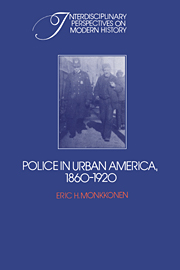1 - The historical development of the police
Published online by Cambridge University Press: 23 October 2009
Summary
To prevent the commission of crime is a paramount object, and if the appearance of the police, in a dress distinguishing them from other citizens, will tend to this result, it is well worth the experiment …
Boston, Annual Report of the Chief of Police (1857)The urban locus of policing
Because the details of the development of the criminal justice system, and especially of the police, in the nineteenth and early twentieth centuries have inherent interest, it has been relatively easy for historians to avoid a deeper, more analytic view other than that which comes from narration and description. This is not to deny the value of such description and chronicling, for it is valuable, but to demonstrate the difficulty of understanding underlying relationships in the urban police across the United States in the nineteenth century. We know that, with only slight variations, police forces have evolved into much the same model across the nation today, but we need to know if each police system followed the same developmental path and if each evolved from the same starting point. If the police in different cities began from completely different points, converging only with the completion of the moves into uniform, the police must have been shaped by similar external forces. If, however, all cities had the same kind of pre-uniformed police that followed the same evolutionary path to the uniform, then it is unclear what kinds of pressure shaped the change – internal, external, or both.
- Type
- Chapter
- Information
- Police in Urban America, 1860–1920 , pp. 30 - 64Publisher: Cambridge University PressPrint publication year: 1981
- 1
- Cited by



